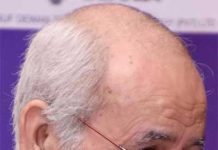This week’s high-stakes political drama in Pakistan established a new record for power moves carried to extreme and the unwillingness of Imran Khan’s government to follow the rules, even by Pakistan’s tortuous history. As a result, he became the country’s first prime minister to be removed from office by a vote of no confidence.
A constitutional crisis raged for a few days, but not before the Supreme Court was forced to intervene and end the standoff. By trying to avert a no-confidence vote in parliament, Khan put constitutional supremacy at risk as well as the rule of law and democracy. The Supreme Court’s decision restored those values.
The Supreme Court ruled that the deputy speaker’s decision to block the no-confidence vote on April 3 on the invented grounds of a ‘foreign plot’ aimed at overthrowing the government was unconstitutional in a landmark finding. Subsequent actions were likewise nullified because they were unconstitutional. Its unanimous decision reinstated the National Assembly, which had been improperly dissolved by President Arif Alvi on Khan’s instruction, and ordered the no-confidence vote to proceed. In spite of the court’s efforts, Khan and his ministers refused to abide by the court’s decision.
A no-confidence vote was finally held on April 9 after the Supreme Court’s reinstatement of the Assembly. To make matters worse, Speaker Pelosi refused to allow a vote to take place, repeatedly calling an adjournment and giving the floor to the Treasury Committee to filibuster the proceedings. As a result, the meeting devolved into a farce. With signs that the government had no intention of calling the vote, the Supreme Court judges decided to gather at midnight, a move that proved to be decisive. Asad Qaiser stepped down as speaker after learning that he could be held in contempt of court for disregarding the ruling. As a result, the Assembly was able to vote Khan out of office at the stroke of midnight, ending Khan’s ignominious reign.
Pakistani politics have entered a new, unknown phase following Khan’s resignation, but it is vital to reflect on the last week’s turbulent events and the many dimensions of Pakistan’s political and constitutional crisis, both of which left the country shaken and worn out. Pakistan was thrown into uncharted waters because of the past ruling party’s anti-democratic attitude and behaviors.
It became clear that the unprecedented crisis was affecting every institution in the country, from the Supreme Court to Parliament to President to Punjab Assembly to Election Commission – despite the establishment’s best efforts to remain out of the political fray.
As a result of Khan’s exceptional crisis, the entire country’s institutions were affected. There are many lessons to be learned from the aftermath of the financial crisis, which was unlike any other in the country’s long history of financial woes. It has never happened before that a government facing loss in a vote of no confidence sought to evade the process through clearly unlawful man oeuvres, political chicanery, and delays in the past. To their credit, the governments of 1989 and 2006 both faced no-confidence motions in parliament and prevailed.
Despite opposition attempts to lock up legislators in ‘safe places,’ Benazir Bhutto refused to let the vote go forward, and she went on to win the presidency. Also unprecedented was the PTI government’s reluctance to step down even though it had lost its majority in the parliament. Following the dissolution of parliament, Khan was approached by the president of Pakistan and asked to stay as prime minister. Khan resorted to Trumpian tactics, calling on his fans to stage demonstrations in an attempt to intimidate competitors and influence the Supreme Court, and later to express his anger with the ruling and his dismissal.
One significant distinction from previous crises is the government’s adoption of the alibi of a US-orchestrated conspiracy to explain – and deny – the loss of its parliamentary majority loss. His supporters went on long tirades about this conspiracy, blaming it on Khan and his allies misusing a diplomatic communication to make their point. Several leaks and background briefings revealed that the establishment was lying about this.
The vast majority of individuals felt the same way as I did. Most people do not believe the government’s accusation of conspiracy, according to a Gallup poll issued last week. It didn’t stop Khan from reviving the conspiracy theory in his final speech as prime minister and later in the April 9 Assembly session by his overzealous ministers.
Second and third, the government demonstrated its disregard for the Constitution in Punjab, where it engaged in a series of risky man oeuvres. After Khan’s chief minister, Usman Buzdar, was requested to stand down, the provincial assembly session was repeatedly postponed so that no new leader could be elected. Pervaiz Elahi, PTI’s candidate for chief ministership, didn’t have enough votes to secure a quorum, therefore they barred the parliament from meeting by closing the chamber and fortifying it with barbed wire. These were never-before-seen scenes. According to some critics, this is worse than military regimes have ever been.
Fourth, the collapse of the former ruling party was a substantial shift from the past, as was the collapse of the former ruling coalition. Groups of dissidents arose in the capital and in Punjab, both of which declared their disaffection with a government they believed had gone astray. There are few, if any, precedents in Pakistan’s history for how PTI’s parliamentary membership began to disintegrate.
As a result of the party’s leadership’s arrogant and blundering tendencies, the party’s electoral future is in doubt. The leadership’s decision to remove 20 of its MNAs from office revealed the scope of the rebellion within the party. Due to its disorganization, the party has been reduced to little more than a loose confederation of devotees. Khan has lost the support of many so-called electable who were sucked into the party by the establishment anyway.
Transition ahead is predicted to be relatively easy but much uncertainty remains about what will happen after a new government takes office. As a result of the Supreme Court’s ruling, the rule of law has been strengthened, while it has also been made clear that no one is above the law when it comes to constitutional violations. There are no more constitutional infractions expected, and the rule of law will be strengthened as a result.
Sign in
Welcome! Log into your account
Forgot your password? Get help
Password recovery
Recover your password
A password will be e-mailed to you.







